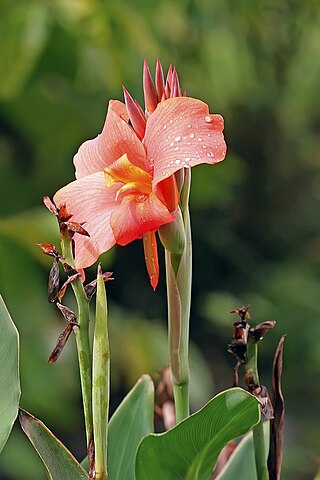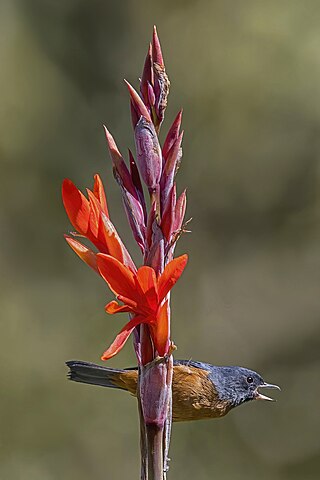Gallery
- Canna 'Trinacria Variegata'
Canna Italian Group 'Trinacria Variegata'. The earliest mention of this cultivar is in 1927, An Amateur in an Indian Garden by S. Percy-Lancaster, F.L.S., F.R.H.S., M.R.A.S., in which it was described and referred to by this name.
A small Italian Group cultivar; variegated foliage, oval shaped, white margin, spreading habit; round stems, coloured green + purple; clusters of flowers are reflexed, yellow and white, staminodes are large, edges ruffled, petals red, fully self-cleaning; seed is sterile, pollen is low fertile; rhizomes are long and thin, coloured white; tillering is average.
It has eye-catching variegated leaves, with large butter-yellow blooms, marked by this plants signature - a white stripe down the centre of each petal forming a white cross. It has variegated leaves of green with pale yellow variegation parallel to the veins.
Nurserymen folk legend has it that in 1923, or thereabouts, a consignment of Canna 'Trinacria' rhizomes was despatched to Siam, now Thailand, from a nursery in California. When it arrived at its destination and was grown out it was found to have variegated foliage. A sample was returned to the nursery with a demand for a refund or replacement as it was not what had been ordered.
This mutation was probably caused by the extreme conditions endured in transport from California to Thailand in the days before air travel. The cultivar was examined in the 1960s by Dr. Khoshoo, who stated that this was not a chimeral mutation.

Canna or canna lily is the only genus of flowering plants in the family Cannaceae, consisting of 10 species. All of the genus's species are native to the American tropics and naturalized in Europe, India and Africa in the 1860s. Although they grow native to the tropics, most cultivars have been developed in temperate climates and are easy to grow in most countries of the world, as long as they receive at least 6–8 hours average sunlight during the summer, and are moved to a warm location for the winter. See the Canna cultivar gallery for photographs of Canna cultivars.

Variegation is the appearance of differently coloured zones in the leaves and sometimes the stems and fruit of plants. Species with variegated individuals are sometimes found in the understory of tropical rainforests, and this habitat is the source of a number of variegated houseplants. Variegation is caused by mutations that affect chlorophyll production or by viruses, such as mosaic viruses, which have been studied by scientists. The striking look of variegated plants is desired by many gardeners, and some have deliberately tried to induce it for aesthetic purposes. There are a number of gardening books about variegated plants, and some gardening societies specialize in them.

Canna indica, commonly known as Indian shot, African arrowroot, edible canna, purple arrowroot, Sierra Leone arrowroot, is a plant species in the family Cannaceae. It is native to much of South America, Central America, the West Indies, and Mexico. It is also naturalized in the southeastern United States, and much of Europe, sub-Saharan Africa, Southeast Asia, and Oceania.
Canna 'Austria' is a medium sized Italian Group Canna cultivar with green foliage, oblong shaped, upright habit; oval stems, coloured green; flowers are cupped, self-coloured yellow, throat orange-red spots on yellow, staminodes are large; seed is sterile, pollen is low fertile; rhizomes are long and thin, coloured white; tillering is prolific. Introduced by C. Sprenger, Dammann & Co., Naples, Italy, EU in 1893.
Canna 'Phasion' is a medium sized Italian Group cultivar; green, bronze and pink variegated foliage, ovoid shaped, branching habit; oval stems, coloured red; clusters of flowers are open, tangerine-orange and burnt-red, staminodes are large, edges frilled, petals purple with farina, fully self-cleaning; seed is sterile, pollen is sterile; rhizomes are thick, up to 3 cm in diameter, coloured white and purple; tillering is average. Originally a spontaneous mutation, probably of Canna 'Wyoming', as it has been known to revert its foliage colour to that identical to that old cultivar. Sold in the US and elsewhere as Canna Tropicanna®, it was protected under US Plant Patent #10,569. Because the patent was issue on 1998-08-25, it has now expired and propagation is now allowed. The plant can be sold under its cultivar name Phasion.

Canna 'Florence Vaughan' is a medium Crozy Group canna cultivar; green foliage, oval shaped, branching habit; oval stems, coloured green; flowers are open, yellow with red spots, staminodes are medium size, edges regular, fully self-cleaning; fertile both ways, not self-pollinating or true to type, capsules globose; rhizomes are thick, up to 3 cm in diameter, coloured white; tillering is average. Introduced by A. Crozy, Lyon, France in 1892.
Canna 'Bengal Tiger' is an Italian Group canna cultivar with variegated foliage; plant height 190 cm; foliage height 140 cm; upright stems and gently spreading leaves; ovoid foliage, background of green (137A); veins variegated yellow, but paler in places (13D); maroon edge to leaf; staminodes, labellum and stamen bright orange (28B) blushed a darker, reddish (32A) in places; yellow (15A) on edges; stigma deep orange-red; petals strongly flushed red. The flower has a crumpled silk appearance; seed and pollen has very low fertility levels; rhizomes thick, up to 3 cm in diameter.
Canna 'Yellow King Humbert' Burbank is a medium sized Italian Group Canna cultivar; foliage green, but often variegated purple markings and occasionally whole leaves purple, oval shaped, spreading habit; oval stems, coloured green + purple; flower clusters are open, spotted, colours yellow with red spots, often large red markings and occasionally whole flowers red, staminodes are large; seed is sterile, pollen is sterile; rhizomes are long and thin, coloured white and purple; tillering is prolific.
Canna 'Roi Humbert' is an Italian Group canna cultivar; bronze foliage, ovoid shaped, spreading habit; oval stems, coloured purple; flowers are cupped, self-coloured scarlet, staminodes are large, edges ruffled, fully self-cleaning; seed is sterile, pollen is sterile; rhizomes are thick, up to 3 cm in diameter, coloured purple; tillering is average. Introduced by C. Sprenger, Dammann & Co, Naples, Italy, EU in 1908.
Sydney Percy-Lancaster was an English landscape gardener who worked in India. Both his father as well as his son worked as gardeners.
The so-called American Elm cultivar Ulmus americana 'Variegata' was a Belgian clone mentioned by Wesmael in Bulletin de la Fédération des sociétés d'horticulture de Belgique, 1862, as Ulmus americana var. variegataHort. It was marketed by the Baudriller nursery of Angers as U. americana foliis variegatis. Wesmael's herbarium specimens, however, held in the Botanic Garden, Meise, both of his Ulmus americana and of his Ulmus americana var. variegata, do not appear to show American white elm leaves. It is known that nurseries in Europe and America marketed the golden wych elm Ulmus glabra 'Lutescens' as Ulmus americana aurea, and it is likely that Wesmael's Ulmus americana variegata was similarly misnamed, and perhaps derived from a reverting branch of aurea, whose leaves it resembled.
The Wych Elm cultivar Ulmus glabra 'Albo-Variegata' was first mentioned by Weston in 1770 as U. glabra var. variegata. An U. campestris latifolia albo-variegataHort. was distributed by the Späth nursery, Berlin, from the 1890s to the 1930s.

The Field Elm cultivar Ulmus minor 'Argenteo-Variegata' or simply 'Variegata', known in Australasia and North America as Silver Elm or Tartan Elm, is said to have been cultivated in France from 1772. Green noted that variegated forms of Field Elm "arise frequently, and several clones may have been known under this name". Dumont de Courset (1802) listed an U. campestris var. glabra variegata, Loudon (1838) an U. nitens var. variegata, and Wesmael (1863) an U. campestris var. nuda microphylla variegata.
The Field Elm cultivar Ulmus minor 'Picturata' was listed in the 1880 catalogue of Simon-Louis, as Ulmus picturataCripps, suggesting an English origin in the nursery of Thomas Cripps of Tunbridge Wells, Kent, who marketed elm cultivars in the 1860s. Clibrans' nursery of Altrincham, Cheshire, marketed it in the early 20th century as Ulmus campestris picturata variegata, their Ulmus campestris being English Elm. Elwes and Henry (1913) placed it under English Elm cultivars.
The Wych Elm cultivar Ulmus glabra 'Pendula Variegata' was first described in 1850, and later by J. F. Wood in The Midland Florist and Suburban Horticulturist (1851) as U. montana pendula variegata, the 'broad-leaved variegated weeping mountain elm', and was said by him to have originated in and been distributed by the Pontey nursery of Kirkheaton, Huddersfield, Yorkshire. It was listed by Hartwig & Rümpler in Illustrirtes Gehölzbuch (1875) as Ulmus montana (:glabra) var. pendula variegataHort.
Canna 'Musaefolia' is a cultivar in to the Foliage Group of Cannas. The cultivar was first described in the first work devoted to Canna, Le Canna, authored by M. Chaté in 1867 with Monsieur Théodore Année. The Musaefolia members of the Foliage Group consist of a specimen that was accepted as a native species of Peru by the experts of the time and at least 7 hybrids and cultivars carrying that parentage. The original "species" was unique because it was without rhizomes, and required to be kept constantly growing. No such species is known to exist in this age, and leading authorities treat C. musaefolia as a synonym of C. paniculata.
Canna 'Trinacria' is a tall 'Italian Group' Canna cultivar; with light green foliage, large, oval shaped, branching habit; clusters of flowers are open, sulphur-yellow with faint red spots in the throat, staminodes are large, throat pearl base; labellum is sulphur-yellow, throat pearl; stamen is sulphur-yellow, style is sulphur-yellow, petals green, fully self-cleaning, good bloomer; seed is sterile, pollen is low fertile; rhizomes are long and thin, coloured white; tillering is prolific. Introduced by C. Sprenger, Dammann & Co., Naples, Italy, EU.
Théodore Année was a French horticulturist. He was a wealthy diplomatic consul in South America when he retired to France in the mid-1840s and settled in rue des Réservoirs, Passy, Paris, where he devoted himself to the culture of tropical plants from South America, having brought back with him the taste for plants with beautiful foliage, especially the Canna genus.